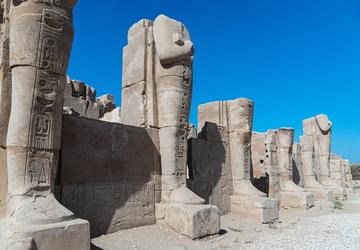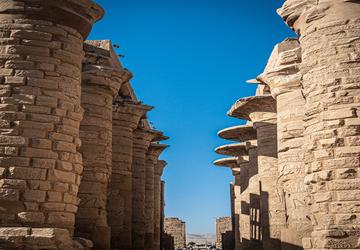Unraveling The Mysteries Of Egypt's Ancient Sites: a Journey Of a Lifetime
Egypt has fascinated history buffs, archaeologists and travelers for centuries. Famous for its pyramids and pharaohs, this ancient land has captured the imagination of people from all over the world. Egypt's ancient sites bear witness to its rich and complex history. From the mystical Sphinx to the majestic Valley of the Kings, these ancient sites have fascinated us for centuries.
Despite the passage of time, these ancient wonders still harbor many secrets and mysteries that have yet to be solved. Exploring ancient Egypt and traveling through ancient Egyptian history is an experience of a lifetime. This article delves into the mysterious and iconic ancient sites of Egypt, revealing long-held secrets that have been hidden in darkness for thousands of years.
The Great Pyramids of Egypt: Eternal Monuments
The Pyramids of Giza hold an important place in Egyptian history and are widely considered to be one of the most famous ancient sites in the world. These impressive structures built by the ancient Egyptians have stood the test of time and are enduring testament to their engineering excellence and unwavering ambition.

The ancient Egyptians built three great pyramids, Cheops, Chephren, and Menkaure, which were commissioned tombs for pharaohs. Considered one of the Seven Wonders of the Ancient World, the Pyramid of Khufu is the oldest and largest pyramid in Egypt.
A mystical creature, the Sphinx has been a symbol of intrigue and wonder for centuries. It served as a guardian over the pyramids of Egypt, inspiring countless theories and conjectures about its origin and purpose.
Pyramids have long been the subject of fascination and curiosity, and their construction is well documented. But despite extensive research, many mysteries surrounding these ancient structures remain unsolved. These mysteries include the technology used to move and position the boulders, and the possible existence of hidden chambers in Egyptian pyramids.
Valley of the Kings: Royal Necropolis
Luxor is a modern city in Egypt that is home to several important temples of great historical importance. Among them, the huge Karnak Temple Complex and the well-preserved Luxor Temple are particularly eye-catching. The ancient Egyptians firmly believed in the existence of gods and goddesses, and built temples to commemorate and worship them. These temples were considered the abodes of the gods and were an integral part of the religious life of the ancient Egyptians.
Each temple is dedicated to a specific god or goddess and is decorated with intricate carvings and paintings depicting their stories and legends. Monks and priestesses are responsible for maintaining the shrines and performing daily rituals and ceremonies to appease the gods and ensure their blessings to the people. Karnak was the center of worship of the awesome god Amun-Ra, and its vast grounds are considered one of the largest sacred complexes in the world.
Located on the west bank of the Nile near Luxor, the Valley of the Kings is a unique burial site for New Kingdom pharaohs. This remote and inhospitable valley has produced more than 60 tombs, including the famous tomb of Tutankhamun, which was discovered almost intact in 1922. The discovery of this important site has brought the young ruler into the public spotlight and sparked renewed interest in the study of ancient Egypt.
Tutankhamun's tomb offers a unique insight into ancient Egyptian culture's beliefs and practices regarding death and the afterlife. The burials in the valley offer unprecedented insight into the customs and traditions of this fascinating civilization.
Although archaeologists have been working to unravel its mysteries, the valley remains shrouded in mystery. The search for the tombs of famous pharaohs such as Ramses VIII and Queen Nefertiti continues today.
Mysterious Abu Simbel: Monuments of Power
The temples of Abu Simbel in southern Egypt near the Sudanese border are a remarkable tribute to the power and splendor of the pharaoh Ramses II. Meticulously carved into sandstone cliffs, these temples served the dual purpose of honoring the deity and displaying the pharaoh's powers.
The Great Temple of Ramses II is the larger of the two temples, with four colossal statues of the pharaoh flanking the entrance. Standing over 65 feet tall, these statues are a testament to the king's greatness and power. Built by Ramses II in honor of Queen Nefertari, the Temple of Hathor is adorned with a stunning array of beautifully carved statues and reliefs, as impressive as those found in the colossal temples.
Abu Simbel is a remarkable historical site known for its remarkable architectural precision. The temple was designed with great attention to detail - a testament to the advanced engineering skills of the ancient Egyptians.
The temple is particularly notable for its unique design, which allows the sun's rays to enter its inner sanctum on two specific days of the year - February 22 and October 22. The phenomenon illuminates the statues of three important deities - Ramses II and Amon-Ra, and Ra-Horahti - a stunning sight that has captivated tourists for centuries. This incredible building coincides with the pharaoh's birthday and coronation day.
Temple of Philae: Sanctuary of Isis
Located on the picturesque island of Agilkia in the middle of the Nile, the Temple of Philae is an idyllic and enchanting place. The complex dedicated to the goddess Isis dates back to the Ptolemaic and Roman periods and was an important center of worship for the cult of Isis. The temple's exquisite carvings and inscriptions provide valuable insights into the religious practices of ancient Egyptian and Greco-Roman cultures.

The temple was originally located on the island of Philae. However, it was painstakingly moved to Agilkia due to the construction of the Aswan Dam in the 1960s and subsequent flooding. The extraordinary efforts to save the temple from being submerged ensured that its beauty can be passed down from generation to generation.
Diploma
Exploring Egypt's ancient ruins is the adventure of a lifetime, inspiring a deep sense of wonder and admiration. Take a journey through time and unravel the mysteries of this great civilization as you walk the ancient paths of the pharaohs and delve deeper into the magnificent temples, tombs, and monuments they built.
For history buffs, a journey through Egyptian history and Egyptian monuments offers a wealth of mysteries waiting to be unraveled. Whether you're a seasoned tourist or a budding archaeologist, these mysteries are waiting to be discovered.
Prepare for an unforgettable adventure in the land of the pharaohs. Pack your bags, put on your adventure hat and get ready for a unique trip!







